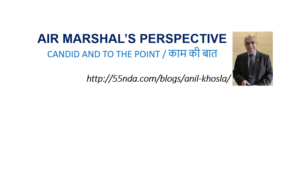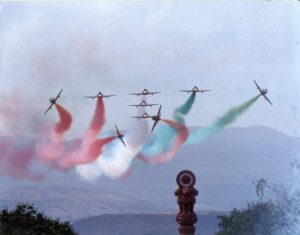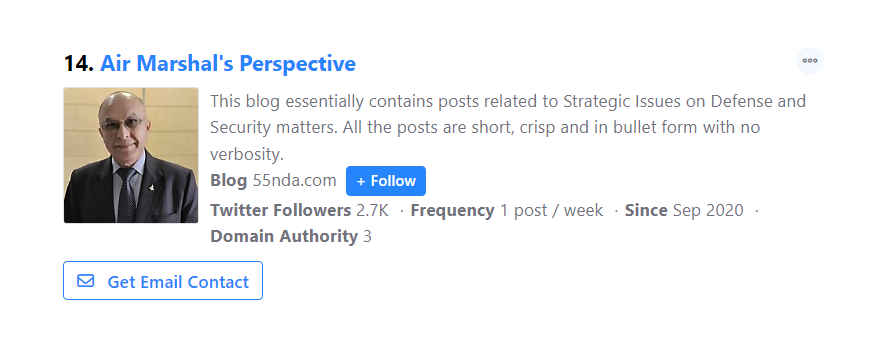
My Article published in the SP Aviation’s
Aero India special e-magazine on 10 Feb 25.
Aero India. Aero India is a premier aerospace and defence exhibition held biennially in India, serving as a vital platform to showcase the nation’s advancements in aviation technology, defence capabilities, and aerospace innovation. Organised by the Ministry of Defence, it attracts global defence manufacturers, policymakers, and military leaders, fostering collaboration and strategic partnerships. The event aligns with India’s “Atmanirbhar Bharat” (self-reliant India) initiative, emphasising indigenous manufacturing and technology development. Aero India is crucial in enabling collaborations with global players and enhancing India’s defence exports and procurement programs. The event highlights key emerging trends, including artificial intelligence, space-based defence systems, and unmanned aerial vehicles (UAVs). Overall, Aero India is a crucial event that strengthens India’s defence ecosystem.
IAF Challenges. The Indian Air Force (IAF) faces significant challenges due to shortages in fighter aircraft, force multipliers, and key operational assets, impacting its ability to meet long-term strategic goals. One of the most pressing concerns is the shortfall in fighter squadrons. While the induction of advanced platforms such as the Rafale has boosted capability, the slow pace of procurement and delays in indigenous programs like the Tejas Mark 2 and the Advanced Medium Combat Aircraft (AMCA) have created capability gaps. The IAF also faces shortages in critical force multipliers such as Airborne Early Warning and Control (AEW&C) systems, aerial refuelling tankers, and drones essential for extending the operational reach and maintaining air superiority in prolonged conflicts. Additionally, the service faces numerous other challenges. Progress remains slow despite efforts to address these issues through the Make in India initiative and increased defence budgets. Bridging these gaps requires accelerated procurement and streamlined production of indigenous platforms.
Adversarial Threats. The Indian Air Force (IAF) faces growing challenges due to the rapid modernisation and expansion of both the Pakistan Air Force (PAF) and the People’s Liberation Army Air Force (PLAAF), which are enhancing their capabilities through advanced platforms and strategic cooperation. With significant support from China, the PAF has made notable progress in fleet modernisation by inducting advanced fighter jets such as the JF-17 Thunder Block III, equipped with AESA radars and beyond-visual-range (BVR) missiles. The PAF’s procurement of Chinese J-10C fighters, featuring advanced avionics and electronic warfare capabilities, has further narrowed the technological gap with the IAF. Pakistan’s focus on enhancing its air defence network, integrating long-range surface-to-air missile systems (SAMs), and investing in unmanned combat aerial vehicles (UCAVs) pose asymmetric threats to India’s air dominance. Meanwhile, the PLAAF presents an even greater challenge with its rapid expansion and technological advancements. China’s deployment of fifth-generation stealth fighters such as the J-20 and an extensive fleet of modern aircraft like the J-16 and H-6K bombers enhances its capability for long-range strikes and air superiority missions. It has even flown the sixth generation prototypes. The PLAAF’s focus on network-centric warfare, integrating artificial intelligence, electronic warfare, and space-based assets, gives it a strategic edge. Furthermore, China’s expanding airbases in Tibet and Xinjiang, with enhanced infrastructure and support systems, allow for sustained air operations along the Indian border. The combined threat from the PAF and PLAAF places immense pressure on the IAF to modernise its fleet rapidly, enhance its force multipliers, and enhance its operational readiness.
Aero India 2025. Aero India 2025 presents a crucial opportunity for the Indian Air Force (IAF) to address its operational challenges by exploring advanced aerospace and defence technology solutions. It would provide a critical opportunity to find sustainable solutions through international collaboration and Indigenous innovation. The IAF must leverage the event to accelerate procurement, foster strategic partnerships, and enhance Indigenous capabilities. Furthermore, global defence suppliers (foreign and Domestic) would gain an understanding of India’s military modernisation plans.
Major Challenges Faced by the Indian Air Force
Squadron Strength Shortfall. One of the most significant challenges for the IAF is the depletion of fighter squadrons. The sanctioned strength of 42 squadrons is essential to counter a potential two-front war scenario. However, the IAF currently operates around 31-33 squadrons, mainly due to the phased retirement of ageing MiG-21s and delays in acquiring replacements. The induction of platforms such as the Rafale has helped, but further acquisitions and indigenous production are crucial to bridge the gap.
Force Multiplier Shortages. The Indian Air Force (IAF) faces challenges in enhancing its force multiplier capabilities, which are critical for maintaining a strategic edge in modern warfare. Force multipliers such as airborne early warning and control (AEW&C) systems, mid-air refuelling tankers, electronic warfare (EW) platforms, drones, and advanced intelligence, surveillance, and reconnaissance (ISR) assets play a pivotal role in extending the IAF’s operational reach and effectiveness. However, the current fleet of these assets is limited, constraining the IAF’s ability to sustain prolonged operations, especially in high-intensity conflict scenarios.
Dependence on Imported Technology. Despite significant strides in indigenous production, the IAF remains dependent on foreign suppliers for critical platforms, components, and weapon systems. This dependence affects operational readiness and strategic autonomy, making accelerating domestic research and development imperative.
Adapting to Changes in Warfare. The Indian Air Force (IAF) faces significant challenges in adapting to the rapidly evolving nature of modern warfare, characterised by advancements in technology, cyber threats, and the increasing importance of multi-domain operations. The growing emphasis on unmanned systems, artificial intelligence, and network-centric warfare demands a paradigm shift in operational tactics and procurement strategies. Cyber security threats also pose a significant risk, as adversaries invest heavily in electronic and information warfare capabilities. The IAF must enhance its capabilities in space-based surveillance, drone warfare, and electronic warfare to stay ahead in a rapidly changing battlefield environment.
Infrastructure Challenges. The Indian Air Force (IAF) also faces infrastructure challenges that directly impact its operational readiness, modernisation efforts, and ability to respond swiftly to emerging threats. One of the concerns is the airbases, particularly those located in remote and strategically sensitive regions in the northeastern states. Many of these bases require substantial upgrades to support the deployment and maintenance of modern fighter jets. The lack of sufficient hardened aircraft shelters (HAS) and blast pens leaves critical assets vulnerable to enemy strikes, especially in high-tension areas like Ladakh and Arunachal Pradesh. Another challenge is the storage and handling of advanced weaponry and ammunition. Modern air warfare demands the deployment of precision-guided munitions, long-range missiles, and advanced electronic warfare suites, all requiring specialised storage and maintenance infrastructure.
Maintenance and Logistics Challenges. The Indian Air Force (IAF) faces maintenance and logistics challenges impacting operational readiness and efficiency. With a diverse fleet comprising legacy aircraft alongside modern platforms, maintaining a seamless supply chain for spare parts and repairs is a complex task. Dependence on foreign suppliers for critical components often leads to delays due to geopolitical and logistical hurdles. IAF’s maintenance, repair, and overhaul (MRO) infrastructure and supply chain management require upgrades to meet the demands of modern warfare.
Expected Solutions
To mitigate its challenges, the Indian Air Force (IAF) must prioritise modernisation, self-reliance, and operational efficiency. Investing in indigenous production under the “Make in India” initiative can reduce dependency on foreign suppliers and ensure a steady supply of spare parts. Strengthening force multipliers such as AWACS, aerial refuelling, drones, and ISR assets is crucial for strategic superiority. Improved logistics management and cyber security enhancements will further bolster the IAF’s combat readiness in future conflicts. Upgrading maintenance, repair, and overhaul (MRO) facilities and adopting advanced technologies like artificial intelligence and predictive maintenance will enhance fleet availability. Aero India 2025 will be a convergence point for industry leaders, defence manufacturers, and policymakers to explore solutions to these pressing challenges. Some of the thrust areas include:-
Capability vis-à-vis Capacity. Warfighting capabilities and the capacity to sustain operations are both essential. It is a combination of quality and quantity. While the capabilities of Indian air power (e.g., reach, high altitude operations, precision, standoff, all-weather operations, airlift capability, etc.) have developed well, the numerical strength of air assets like fighter aircraft, combat enablers, AWACS, AAR, Drones, etc., needs to be increased.
Aircraft Type and Capability. The type of aircraft being used, their capabilities, payload capacity, and mission versatility significantly affect how effectively and efficiently air operations can be sustained. Therefore, a balance between quality and quantity needs to be maintained. In the Indian context, besides inducting the LCA to make up the numbers, an adequate number of advanced fighter aircraft must also be inducted. Aero India 2025 will showcase options for modern fighter jets to augment the IAF’s capabilities.
Boosting Indigenous Production. In the long run, Self-reliance is the only way. The Indian Air Force has always encouraged the development of indigenous defence production capability, and it is one of its key result areas. The event will emphasise indigenous defence production under the Make in India and Atmanirbhar Bharat initiatives. It will also focus on partnerships with global defence companies for technology transfer, joint ventures, and local manufacturing of critical systems such as engines, avionics, and radars.
Advanced Force Multipliers. In addition to increasing their numbers, integrating force multipliers seamlessly with combat aircraft and ground-based systems requires advanced networking and data-sharing capabilities. To overcome these challenges, the IAF must accelerate indigenous development, enhance interoperability with allied forces, and invest in cutting-edge technologies such as artificial intelligence and space-based ISR to bolster its force multiplier capabilities and maintain air superiority in future conflicts. Aero India 2025 will provide a platform to evaluate and procure force multipliers such as AEW&C systems, aerial tankers, drones, and enhanced electronic warfare systems.
Unmanned Aerial Systems (UAS) and Drone Warfare. The use of unmanned platforms and systems is growing in warfare. This shift is expected to continue as technology advances and the capabilities of unmanned systems improve further. Drones of various sizes and capabilities are taking over the tasks of conventional platforms. Their use is spread across the entire spectrum of threats, ranging from sub-conventional and conventional to long-range attacks. Investment in anti-drone systems is also a need of the hour. Aero India 2025 will showcase the latest advancements in Unmanned Combat Aerial Vehicles (UCAVs), drone swarms, and counter-drone technologies—Indigenous platforms such as the DRDO’s Rustom and Tapas UAVs.
Situational Awareness & Decision Making. One effect of advanced technology on air warfare is the increased pace and intensity of air operations. In such a scenario, the decision-making process must quickly keep up with the OODA cycle. The three most important contributing factors are high situational awareness, a robust and fast network system for information sharing, and AI-based decision-support systems. The solutions may be found in the Aero India.
Space-Based Capabilities. The term airpower has changed to aerospace power, with the aerial warfare envelope expanding to the space domain. Space-based systems and applications are embedded in every aspect of aerial warfare. In Grey zone warfare, the involvement of space-based equipment and systems is even larger. Space-based systems are becoming increasingly crucial in air warfare, providing capabilities such as navigation, targeting, communication, early warning of missile launches and space-based surveillance. The integration of these systems with air assets is expected to continue, providing new opportunities for offensive and defensive operations. Aero India 2025 will highlight these solutions and satellite-based intelligence, surveillance, and reconnaissance (ISR), with the possibility of collaboration with ISRO and global space technology firms.
Cyber and Electronic Warfare Capabilities. Aero India 2025 will emphasise the need to strengthen the IAF’s capabilities in electronic warfare and cyber defence. Solutions like AI-driven cyber threat detection, electronic jamming systems, and next-generation radar technologies will likely be showcased.
Investment in Technology. The Air Force is a technology-intensive service; converting technology into capability is time-consuming. To stay on top of the challenges, there is a need to invest in emerging technologies and ideate about their use in warfare. Technologies impacting the air war include quantum computing, hypersonics, AI, unmanned platforms (including drones and swarm technology), and a network-centric environment. Defence companies would display new defence systems incorporating these technologies.
Loyal Wing Man Concept. Both man- and unmanned platforms have their respective advantages and disadvantages. The thought process for the next generation of platforms is to harness both benefits and develop networked systems in which both can work in an integrated manner. Research is being done in many countries on the “loyal wingman” concept. HAL is likely to disclose the progress of its CATS Program.
Hypersonic. The development of hypersonic platforms and weapons will likely significantly impact air strategy. Hypersonic weapons provide new opportunities for rapid response and long-range strike capabilities with precision. They also pose new challenges in terms of protection and air defence. The high speed and unpredictability of hypersonic weapons will require the development of new air defence strategies, as traditional air defence systems may be unable to detect or intercept these weapons. This could lead to the development of new technologies, such as directed energy weapons or advanced sensors, to counter the threat posed by hypersonic weapons. Also, protective infrastructure would be required to withstand these weapons’ destructive power. These aspects would find their way into Aero India.
Smart Training Aids. The Indian Air Force (IAF) is leveraging modern training aids such as simulators, artificial intelligence (AI), and virtual reality (VR) to enhance combat readiness and operational efficiency. Advanced flight simulators provide realistic, mission-specific training while reducing costs and wear on actual aircraft. AI-driven analytics help personalise training programs, analyse pilot performance, and optimise mission planning. VR technology immerses trainees in highly realistic combat environments, improving situational awareness and decision-making under pressure. These cutting-edge training solutions would find a place in the air show.
Smart Logistics and Supply Chain Management. Efficient and reliable logistics networks and supply chains are crucial for providing fuel, ammunition, weapons, spare parts, other critical supplies, and resources to sustain air operations. Well-maintained supply chains are essential for operational readiness and sustaining a protracted conflict. Industry leaders will present solutions to streamline the IAF’s logistical operations, including tools powered by artificial intelligence, automated inventory management, and improved supply chain networks to ensure the availability of critical spare parts.
Conclusion. Aero India 2025 represents a significant opportunity for the IAF to address its critical challenges and prepare for future readiness. By leveraging cutting-edge technologies, fostering international collaborations, and enhancing indigenous capabilities, the IAF can address the existing gaps. The outcomes of Aero India 2025 will have far-reaching strategic implications for India’s air power capabilities. The event will catalyse India’s vision of becoming a self-reliant aerospace and defence powerhouse, ensuring a robust, future-ready air force.
Please Do Comment.
For regular updates, please register your email here:-
References and credits
To all the online sites and channels.
References:-
- “Modernizing the Indian Air Force: Issues and Challenges” – Journal of Strategic Studies
- “The Role of Aerospace Technology in Enhancing National Security” – Defence and Technology Journal
- “India’s Aerospace Industry: Present Challenges and Future Directions” – Economic and Political Weekly
Government Reports & White Papers
- “Aero India 2025: Indian Aerospace and Defence Industry Report” – Ministry of Defence, India
- “Aero India 2025: What to Expect?” – The Economic Times
- “India’s Aerospace Industry in 2025: A Strategic Overview” – India Today
- “How Aero India is Shaping Future Air Combat” – The Hindu
- “The Role of Technology in the Modernisation of the Indian Air Force” – Institute for Defence Studies and Analyses (IDSA)
- “Challenges and Solutions in Air Force Modernisation” – Centre for Air Power Studies (CAPS)
Disclaimer:
Information and data included in the blog are for educational & non-commercial purposes only and have been carefully adapted, excerpted, or edited from reliable and accurate sources. All copyrighted material belongs to respective owners and is provided only for wider dissemination.












